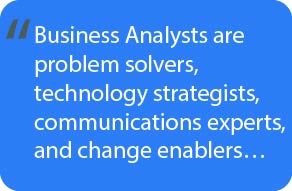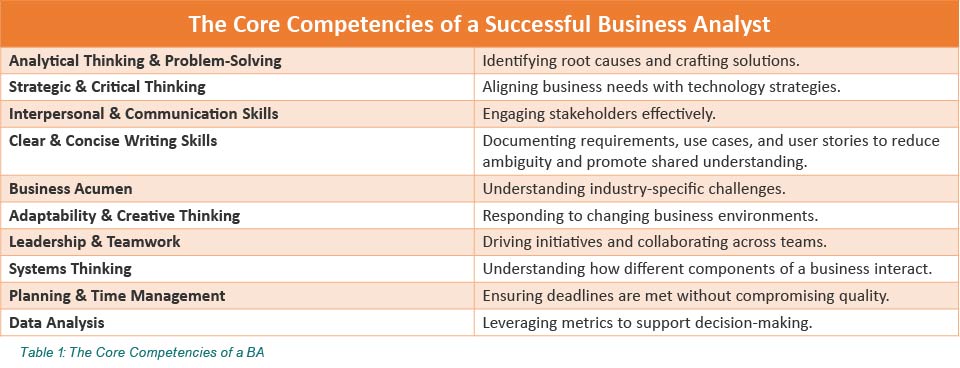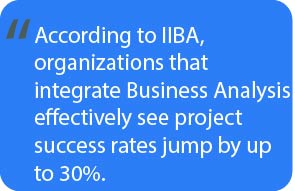1.0 Introduction
Aligning business goals with technology is crucial for long-term success. Without a clear technology strategy, organizations face inefficiencies, miscommunication, and wasted investments. Business Analysis provides the framework to ensure that technological initiatives serve real business needs.
The International Institute of Business Analysis (IIBA) defines Business Analysis as “the practice of enabling change in an enterprise by defining needs and recommending solutions that deliver value to stakeholders.” Business Analysis is a critical function across all business units that ensures efficiency, clarity, and measurable impact.
In today’s fast-moving digital landscape, organizations must be agile, adaptable, and strategically focused. Business Analysts (BAs) provide the insight, structure, and coordination needed to navigate complex transformations successfully, ensuring that businesses remain competitive, efficient, and resilient in changing environments.
2.0 What is a Business Analyst?
Business Analysts are problem solvers, technology strategists, communications experts, and change enablers that unify teams, streamline processes, and deliver measurable outcomes.
2.1 Problem Solvers
BAs diagnose and resolve business challenges. They apply industry-standard frameworks like SWOT analysis, Six Sigma, and Lean principles to identify inefficiencies and propose targeted improvements.
Common inefficiencies include:
- Redundant processes that slow productivity and increase cost.
- Poorly integrated systems causing data inconsistencies.
- Ineffective communication between business and technical teams.
BAs identify these gaps and create structured solutions to enhance operational efficiency and minimize waste.
2.2 Technology Strategists
BAs align technology with business objectives by defining clear requirements and ensuring that selected solutions meet business needs. Some organizations have a Solution Architect role that is distinct from the BA. Solution Architects focus on technical design while BAs work closely with them to establish the foundational requirements and validate that the chosen approach aligns with strategic goals. In smaller organizations more technically oriented BAs may take on the role of Solution Architect, bridging both business and technical considerations to design and implement effective solutions.
BAs utilize various methodologies to ensure project success, for instance:
- Business Process Modeling (BPM): Visualizes workflows to identify inefficiencies and streamline operations.
- Use Case Analysis: Defines user interactions with systems to ensure functionality meets business needs.
- Functional and Non-functional Requirement Analysis: Ensures all business and system needs are captured to avoid gaps in implementation.
By applying these methodologies, BAs facilitate clear communication, reduce misalignment between business and technical teams, and ensure that projects deliver real, measurable value.
2.3 Communication Experts
Effective communication ensures project success and strategic alignment between projects and the rest of the business. In coordination with Project Managers, BAs translate complex business needs and processes into actionable plans that technical teams can execute.
Common communication methods include:
- Requirement documentation and structured specifications.
- Workshops and stakeholder interviews.
- Visual modeling tools like UML diagrams.
BAs also conduct stakeholder analysis to map communication strategies, ensuring that all voices are heard, and expectations are met.
2.4 Change Enablers
Resistance to change is common, but a well-planned approach ensures minimal disruptions and steady progress. BAs play a pivotal role in guiding organizations through the complexities of change. To enable smooth transitions, Business Analysts:
- Develop Effective Communication Strategies: They create clear messaging channels and timelines, ensuring that all stakeholders understand the purpose and benefits of the change.
- Produce Communications Artifacts That Promote Understanding: They prepare status updates, process overviews, and other documentation that clarify what is happening, why it is happening, and what to expect.
- Conduct End User Interviews Throughout the Project: They gather feedback continuously to ensure that new processes or tools meet real-world needs.
- Identify Key Stakeholders and Their Concerns: They address resistance early by consulting those who will be impacted the most, thereby building trust and reducing pushback.
- Assess Change Outcomes: They measure adoption, user satisfaction, and performance metrics to evaluate if changes are delivering the desired results.
- Align Training Needs with Staff Capabilities: They identify skill gaps and plan targeted training sessions so that employees are equipped to work effectively in the new environment.
- Define Clear Transition Plans with Measurable Milestones: They map out each phase of the change process, specifying goals, timelines, and required resources.

3.0 How Business Analysts Deliver Value to Organizations
3.1 Identifying Inefficiencies
Many organizations operate without a clear understanding of their own workflows. Business Analysts conduct comprehensive process analyses to identify inefficiencies that hinder productivity, increase costs, and create operational risks.
BAs utilize techniques such as value stream mapping, root cause analysis, and process flow diagrams to visualize how work moves through an organization. This allows them to pinpoint bottlenecks, redundancies, and inefficiencies that are often overlooked by internal teams.
For example, a company experiencing chronic order fulfillment delays may assume the issue lies with warehouse staff. However, a BA might discover that outdated inventory tracking software is causing stock discrepancies, leading to delays. By mapping the end-to-end process, the BA identifies the real issue. They can then recommend solutions and ensure the implementation of more efficient systems.
This structured approach equips organizations with the insights necessary to enhance operational efficiency, minimize waste, and boost overall performance.
3.2 Minimizing Risks in Technology Implementations
 Thorough planning and risk mitigation strategies are essential to successful technology implementations. Without them, organizations encounter disruptions, budget overruns, or missed targets. BAs play a critical role in reducing these risks by conducting in-depth evaluations at every stage of implementation and providing crucial information and understanding to the planning process.
Thorough planning and risk mitigation strategies are essential to successful technology implementations. Without them, organizations encounter disruptions, budget overruns, or missed targets. BAs play a critical role in reducing these risks by conducting in-depth evaluations at every stage of implementation and providing crucial information and understanding to the planning process.BAs perform:
- Feasibility Studies: Assessing whether a proposed solution is viable, cost-effective, and aligned with business goals.
- Risk Assessments: Identifying potential threats to project success, including technology limitations, process disruptions, and resource constraints.
- Contingency Planning: Developing backup plans to ensure smooth transitions and minimize operational disruptions.
Beyond risk identification, BAs facilitate collaboration between technical teams, business units, and leadership to ensure that project expectations align with strategic objectives.
3.3 Recommending Technology Solutions
BAs play a key role in choosing appropriate technology solutions. In addition to gathering and documenting requirements, BAs thoroughly assess whether organizations should develop custom software or adopt existing platforms (Buy/Build and Solution Selection Analysis). They consider total cost of ownership (TCO), scalability, ease of integration, and long-term maintenance needs for proposed solutions. They also examine factors such as vendor reliability, regulatory compliance, user adoption potential, and alignment with strategic goals.
BAs do more than propose technology. They also advise against solutions that create unnecessary complexity, fail to provide real value, or duplicate capabilities already available within the organization. By analyzing risk, cost, and anticipated benefits, they help organizations avoid costly mistakes and ensure that each investment supports clear business objectives. This comprehensive approach bridges technical capabilities with operational realities, delivering outcomes that genuinely address organizational challenges.
3.4 Ensuring Real Business Value
BAs help define success metrics to ensure that projects and systems deliver measurable benefits. They consider both quantitative and qualitative measures to determine whether an initiative meets broader business goals, such as revenue growth, enhanced customer satisfaction, or streamlined processes. BAs also provide less tangible benefits, including improved employee morale or better brand reputation.
This focus on value can extend beyond IT initiatives. BAs apply the same principles to operational improvements, organizational changes, and strategic investments in any department. They review not only technical requirements but also process efficiencies, organizational readiness, and potential cultural impacts.
BAs use Return on Investment (ROI) analysis to confirm that expected gains outweigh project costs. They also track Key Performance Indicators (KPIs) such as reduced onboarding time, faster response rates, or fewer errors in production. These metrics provide an ongoing view of a solution’s impact on the organization.
For instance, an organization implementing a new Customer Relationship Management system needs to see tangible improvements in sales efficiency, fewer data errors, and better customer retention. BAs collect and analyze data before and after deployment to verify these outcomes. They recommend adjustments if results fall short, ensuring continuous improvement and alignment with evolving business needs.
3.5 Documenting Critical Business Functions
Many organizations overlook the importance of thorough documentation. This oversight often leads to inefficiencies, confusion, and duplicative efforts. BAs play a key role in preventing these issues by creating, organizing, and maintaining documentation that captures the essence of business operations.
Examples of critical documentation that BAs produce or update include:
- Detailed Process Flows: They outline each step of an operation, from initiation to completion.
- Standard Operating Procedures (SOPs): They define how tasks should be performed consistently.
- System Architecture Diagrams: They show how different applications communicate and share data.
- Stakeholder Communication Logs: They record decisions, feedback, and responsibilities.
This documentation provides several benefits:
- It improves collaboration by giving teams a single reference point for organizational knowledge.
- It helps new hires quickly understand processes, reducing onboarding time.
- It lowers operational risks by identifying potential points of failure or compliance gaps in existing processes.
- It supports knowledge transfer across teams, so critical information does not reside in one person’s head.
Moreover, BAs apply the same rigorous documentation standards to non-IT processes, reinforcing that value analysis and process clarity extend beyond software implementations. By ensuring proper documentation, BAs help organizations stay agile, meet regulatory requirements, and build resilience against disruptions. Documentation is a living resource that should be updated as processes evolve, reflecting continuous improvements and lessons learned.
4.0 The Strategic Impact of Business Analysts Across Organizations
4.1 From Startups to Enterprise-Level Companies
The BA role can be adapted to organizations of all sizes. While enterprises may have dedicated BA teams, startups often rely on employees performing multiple roles so the person wearing the BA hat may also be a Solution Architect, Programmer, or even Project Manager. The best developers are also very good BAs because deeply understanding a complex problem is the best way to start solving it. Regardless of organization size, Business Analysis provides a structured approach to decision-making and growth.
4.2 Driving Digital Transformation
BAs help organizations transition to new technologies, ensuring seamless implementation and integration. Their role includes:
- Conducting system testing to validate performance.
- Managing user acceptance testing (UAT) to ensure usability.
- Overseeing implementation to minimize disruption.
- Helping organizations understand their processes and service delivery mechanisms so that the right technology solutions can be applied.
4.3 Enabling Cross-Functional Teams
BAs act as the bridge between business and technical resources, ensuring departments work towards shared objectives. Their involvement fosters:
- Better collaboration.
- Reduced misunderstandings.
- Greater project alignment.
5.0 Why Your Organization Needs Business Analysis
BAs deliver measurable value by:
- Reducing operational costs through efficiency improvements.
- Increasing project success rates by minimizing risks.
- Enhancing innovation through structured problem-solving.
- Improving customer satisfaction by optimizing user experiences.
Organizations must evaluate their processes and identify opportunities for improvement. Business Analysis provides the structure and expertise to optimize workflows, reduce waste, and drive success.
Engage a Business Analyst to explore how your organization can achieve its strategic goals more effectively. Let us connect and discuss how Business Analysis can transform your operations.
6.0 Conclusion
Business Analysts play a crucial role in bridging the gap between business needs and technological solutions. They ensure efficiency, mitigate risks, and drive digital transformation.
According to IIBA, organizations that integrate Business Analysis effectively see project success rates increase by up to 30%. Investing in BA expertise leads to smarter decision-making and sustainable growth.
Leverage Business Analysis to gain a competitive edge. The future of your business depends on it.


